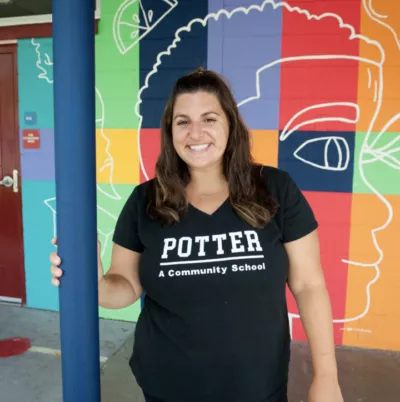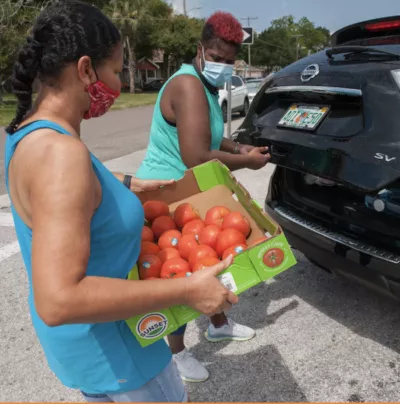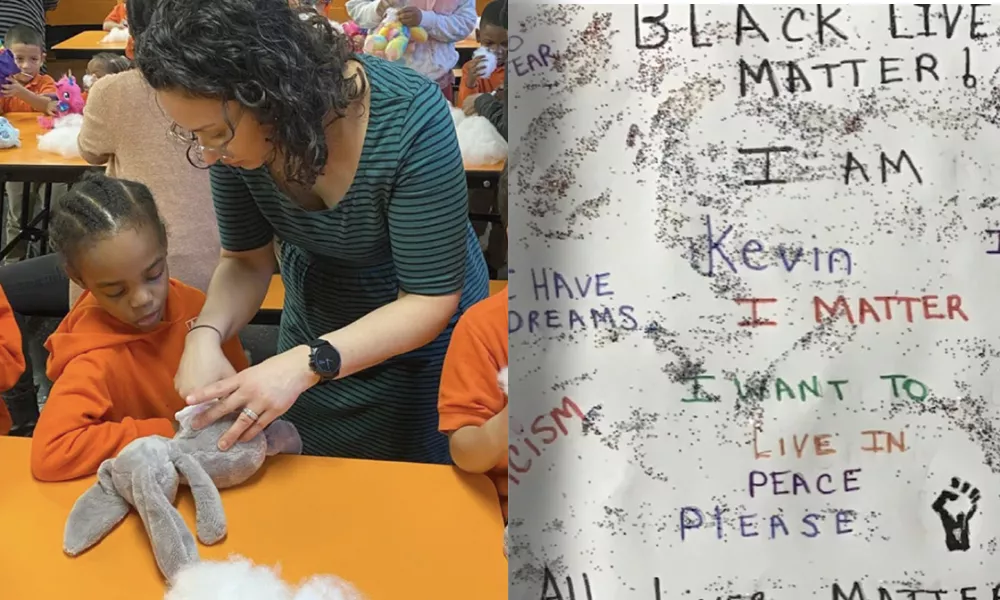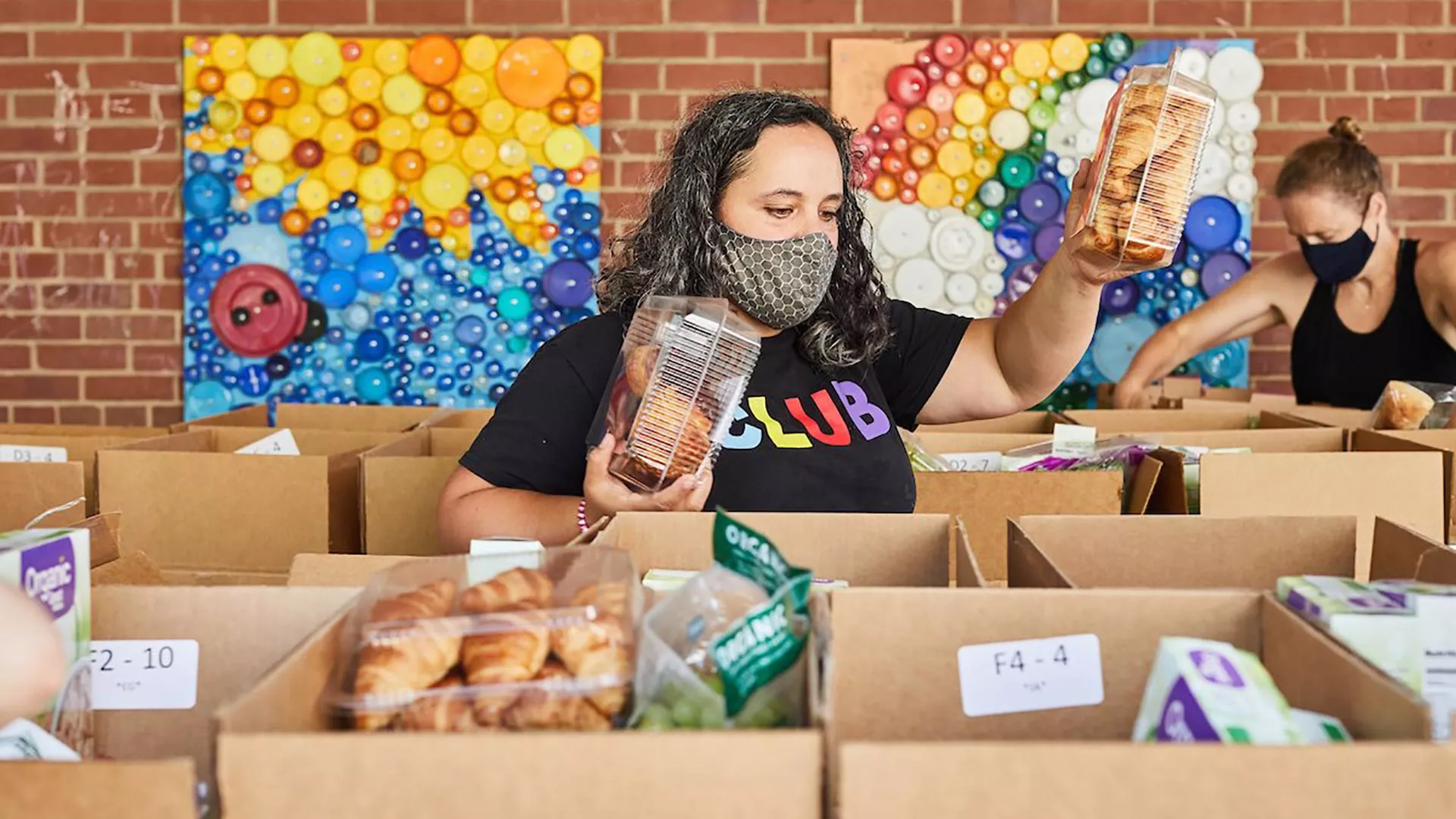For Sarah Madden and her children, Potter Elementary Community School has been a lifeline, not only during the COVID-19 crisis, but well before.
When they had a house fire a year ago and nowhere to go, the staff at the community school in East Tampa, Florida, secured vouchers for food and other necessities and found them housing at Metropolitan Ministries, an organization that offers services for homeless families.
“The school helped me tremendously,” Madden says. “They even handpicked clothes for my kids and called me every day to check in and make sure we were okay.”
Fast forward to March 2020, when COVID-19 closed school buildings, and Potter Elementary offered her another lifeline. Madden’s kids, three of whom are enrolled at the school, had no computers or mobile devices, and Madden had only a smartphone. The school provided the family with a laptop and tablet to share, allowing the children to keep up with their classes.
But the lifeline didn’t end there for Madden and other families who attend the community school. The school’s food pantry broadened into a grab-and-go service of staples, fresh produce, and hygiene products— such as soaps, menstrual products, and diapers—and even provided books for students. They partnered with Tampa’s Black-owned restaurants to deliver 1,000 meals to families.
They connected families to city services that offered relief on utilities and other bills, and they made regular contact with struggling families to find out what they needed and how the school could help.
Potter Elementary is one of six community schools in the Tampa Bay area. Potter, along with three others, launched in the 2019-2020 school year using the NEA-backed Community Schools Model that positions public schools as hubs for neighborhoods, combining academics with extended learning opportunities, family and community events, and an infusion of social services. They all ramped up their services when the pandemic hit, and were positioned to do so easily.
At community schools, a network of local organizations, businesses, and partnerships maintain these social services, sometimes called “wraparound services”—and they have proven to be critical during the COVID-19 crisis.
Emergency Help for the Community

East Tampa, in Hillsborough County, is a predominantly Black community with skyrocketing unemployment and more families living in poverty than anywhere else in the city.
“We were hit hard by COVID-19,” says Meredith Mullen, the community school resource teacher at Potter Elementary. “Hunger, housing, technology barriers—these were some of the challenges our families already dealt with, and we had to figure out how to keep helping them during the closures, then add to and expand those services.”
To connect them with support as COVID-19 surged in Florida, Mullen and other staff acted as service aggregators and information dispensers, directing families to rent relief or information on employment opportunities.
“There was a huge advantage to having existing partnerships in place like the Children’s Board of Hillsborough County and Feeding Tampa Bay, and to just pivot to those,” says Mullen.
Constant Communication
Building trust through open communication is at the heart of what makes a community school work, says Kyle Serrette, NEA Community Schools policy analyst. By continually engaging with parents, schools identify what matters most to families and can work with partners to deliver it.
“Community schools have the channels in place to accurately identify the needs and hopes of the school community, and then to triage those needs,” Serrette says.

At Potter Elementary, that engagement channel is called “Potter Parent Platforms,” a monthly meeting organized by Mullen to bring parents together to voice concerns.
The meeting went online after COVID-19, but the peer-to-peer communication continued, with some parents calling other parents who weren’t online. That’s how the school realized that they’d been missing the mark for some families.
Through its partnership with the Hillsborough Education Foundation, Mullen and her colleagues distributed hot spots and computers to families who needed them. But there were still students not logging on for distance learning or responding to emails.
It turns out, many parents simply didn’t know how to use the technology to help their children.
“We knew there were vast inequities and a gaping digital divide, but now we know you can’t just give a child a laptop and a hot spot and end it there, because many families didn’t know how to get onto a browser, let alone Zoom or Google Meet,” Mullen says. “Without our relationships with the parents, we wouldn’t have discovered that.”
Within a few days, a tech staff member put together a resource guide for digital learning and how to access resources.
No One Falls Through the Cracks
As summertime heat soared across Durham, N.C., so did cases of the coronavirus, especially among the Latino population, which comprises almost half of the families at Club Boulevard Humanities Magnet and Community School (Club). Some students’ parents work in meat-packing plants, many others work in construction, where COVID-19 became rampant. Latinos make up 16 percent of Durham’s population and 70 percent of COVID-19 cases in the area.
“We received lots of personal reports of families getting COVID-19, losing jobs, losing hours, and struggles with paying bills and rent,” says Community Schools Coordinator Megan McCurley. “It put enormous stress on families and children.”

Like all schools that closed last spring, they had students who went off the grid and weren’t heard from when meal distribution and distance learning began. What set the school apart from many others is that Club has McCurley, a dedicated staff member who is a full-time problem-solver and resource provider.
“We’ve come to understand as a community school that you must ask thoughtful questions, dig in, and do a little research, and then turn around with targeted tactics—quickly and strategically,” she says. “Educators can’t do that alone.”
When some school buildings shut down, the school leaders’ first impulse was to call all the parents. Educators were given lists and asked to make calls, even as they were working on distance-learning plans and lessons. Some parents got a call, but didn’t answer, and then that family went to the bottom of the list, or came off the list altogether. With little notice to coordinate call lists or prepare tracking, it was easy for people to fall through the cracks.
But Club took a different approach. Instead of tasking only teachers to make calls, they recruited volunteer parents, the school counselor, and social workers. They set up a shared tracking system, and when they didn’t reach a parent, the family didn’t go to the end of the list.
“We had some parents who wouldn’t answer a call from a number they don’t know,” McCurley says. “So I suggested we text first to identify ourselves and let them know we’d call in five minutes. After that our numbers of answered calls went way up.”
With small tweaks, like a call from a neighbor or a search on social media, she was able to reach all the families except for one—a new family who’d moved to the area in early spring just before the school closures. They didn’t know many people, and they were unreachable following the school shutdown.
Finally, after a lot of worry and brainstorming, McCurley was elated to see the mom show up at their food bank one morning. The mom had heard about it from a friend.
“Now I see her every week when she’s picking up food,” she says. “We talk and check in. We have that connection now, that relationship.”
‘We Are Truly a Community Hub’
It was still winter in New York when murmurings of the coronavirus began to spread. On a cold February morning in Brooklyn, parents packed into a classroom at Brooklyn Landmark Elementary School (BLES, pronounced “bless”) for a monthly Parents and Pancakes breakfast—a popular event that always drew a crowd before the pandemic shutdowns.
Among the discussions that morning was how parents can engage their scholars (what students are called at BLES) by asking questions about their activities or even what they see or hear happening around them. For example, kids might be curious about the coronavirus and why they are seeing some people wearing masks. The discussion proved to be more portentous than anyone imagined.
“It’s been really hard for our families,” says BLES Community School Director Evelyn Vazquez. “We are truly a community hub, and families were in the building all the time for programs or events. So when they couldn’t walk into the school and speak to someone and be so engaged in their children’s learning, it really hurt. The isolation was very difficult.”

The virus also took a physical toll. Vazquez learned that a lot of parents and caretakers got sick. She and her colleagues made sure food and supplies were delivered to the families’ homes and that the families knew where to seek treatment and find free testing sites.
With donated devices for the scholars who needed them, learning continued as efficiently as possible. And volunteer parents, such as Theron Cooper, stepped up to host meetings virtually that had been held at school before the pandemic.
Mr. Cooper, as he is known around the school, has three children at BLES and was a volunteer leader of BLES Kings, a support group that teaches boys how to grow into responsible young men. “There is a lot you can learn outside of a classroom,” says Cooper.
The boys learned to tie a tie, iron a shirt, and not wear their pants way down below their waists. Each meeting, the group would start with homework checks and ice breakers.
Then they would talk about issues facing young men in their community, such as how to conduct yourself when interacting with law enforcement—a lesson that became more heated during the pandemic.
The video of George Floyd’s murder caused a lot of pain and trauma for everyone in the city, particularly in neighborhoods like Brownsville, where BLES is located and where most residents are people of color. The school stepped up, hosting two Black Lives Matter virtual town halls, one for K–2 scholars and one for grades 3–5.
“The scholars shared posters of how they were feeling, and there were a lot of emotions,” says Vazquez. “They talked about their fear and pain and what they have to endure on a daily basis and how scary it is.”
As our country moves forward, Vazquez says she wants us to really think about the way we are engaging families and try to learn from the Community Schools Model.
“Everything that happened highlighted, across the country, that we have so many families at such a disadvantage,” she says. “Schools are vital to them, for meals, for social interaction, for mental health support. We must continue to figure out ways to reach and support families.”


